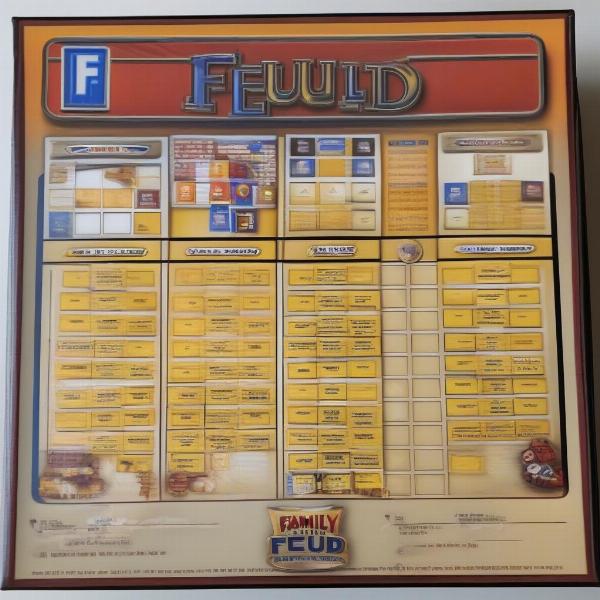Family Feud is a classic game show that has entertained families for decades. Now, you can bring that same excitement home with the Family Feud board game. This guide covers everything you need to know to become a Family Feud champion, from understanding the basic rules to advanced strategies. Get ready to survey says… success!
Understanding the Basics of Family Feud
The objective of Family Feud is simple: guess the most popular answers to survey questions. Two teams compete to reach a certain point threshold, typically 300 points, by correctly guessing the top answers. The team that reaches the target score first wins the game.
Setting Up the Game
Before you start, divide your players into two teams. One person from each team steps up to the face-off podium (or designated area). The first question is read aloud, and the first person to buzz in gets to answer. If their answer is the top answer on the board, their team gets control. If not, the other team gets a chance to steal.
Gameplay and Scoring
The controlling team then tries to guess the remaining top answers. For each correct answer, they earn the corresponding number of points based on the survey results. If they fail to guess all the answers, the opposing team has one chance to steal all the points by guessing just one remaining correct answer.
Advanced Strategies for Family Feud
While the game relies on guessing popular answers, some strategies can significantly increase your chances of winning.
Think Like the Survey
Try to anticipate the most common responses. Put yourself in the shoes of the average person being surveyed. Consider demographics, current events, and general knowledge.
Pay Attention to Your Opponents
Listen carefully to their answers, even if they’re wrong. Incorrect answers can give you valuable clues about what the remaining answers might be. Sometimes, a wrong answer can spark an idea for the correct one.
Utilize the “Strike” System Wisely
If your team gets three strikes (incorrect answers), control goes to the other team. Be strategic with your guesses, especially when you’re unsure. Sometimes, it’s better to pass than risk a strike.
 Setting Up the Family Feud Board Game
Setting Up the Family Feud Board Game
Mastering the Fast Money Round
The Fast Money round is the final stage of the game and the chance to score big. Two players from the winning team take turns answering five questions. They have a limited time to give their answers, adding to the pressure.
Communication is Key
Discuss potential answers with your teammate before the round starts. This can help avoid duplicate answers and maximize your point potential. Brainstorming and strategizing are crucial for success.
Go for the Obvious
In Fast Money, the most obvious answers are often the most popular. Don’t overthink it – go with your gut and aim for the low-hanging fruit.
Stay Calm Under Pressure
The timer can be intimidating, but try to stay focused and relaxed. Take a deep breath and think clearly before answering. Rushing can lead to mistakes and missed opportunities.
 Family Feud Fast Money Round in Action
Family Feud Fast Money Round in Action
Variations and House Rules
There are many ways to adapt Family Feud to suit your group.
Themed Games
Choose a specific theme for your questions, such as movies, music, or sports. This can make the game more engaging and tailored to your interests.
Team Size Adjustments
Adjust the team sizes to accommodate larger or smaller groups. You can even have individuals play against each other if needed.
Point System Modifications
Change the scoring system to make the game easier or more challenging. You could increase the point values for harder questions or award bonus points for specific answers.
 Playing a Themed Family Feud Game
Playing a Themed Family Feud Game
Family Feud: More Than Just a Game
Family Feud is more than just a game – it’s a social activity that brings people together. It’s a chance to laugh, have fun, and create lasting memories.
Expert Insight: “Family Feud is a fantastic way to enhance communication and teamwork skills,” says Dr. Emily Carter, a renowned family therapist. “The collaborative nature of the game encourages players to work together and strategize, fostering stronger bonds and connections.”
So gather your friends and family, dust off that board game, and get ready for a night of laughter and friendly competition. With a little strategy and a lot of enthusiasm, you’ll be well on your way to becoming a Family Feud champion!
Expert Insight: “The beauty of Family Feud lies in its simplicity and accessibility,” adds renowned game designer, Mark Johnson. “The rules are easy to learn, making it a great game for players of all ages and backgrounds.”
Why Family Feud is a Classic
The enduring popularity of Family Feud speaks volumes about its timeless appeal. It combines elements of trivia, strategy, and teamwork, creating a dynamic and engaging experience that resonates with players of all ages. The fast-paced nature of the game keeps everyone on their toes, while the element of surprise keeps the excitement levels high.
Expert Insight: “Family Feud’s success can be attributed to its ability to tap into our inherent desire for social connection and friendly competition,” observes sociologist Dr. Sarah Miller. “The game provides a platform for shared experiences and laughter, strengthening interpersonal bonds and creating a sense of community.”
Conclusion
Learning How To Play Family Feud Board Game is a simple process, but mastering the strategies and nuances can take time. By understanding the rules, utilizing smart strategies, and embracing the spirit of friendly competition, you’ll be well on your way to creating memorable game nights filled with laughter and fun. So gather your family and friends, and get ready to survey say… have a blast!
FAQ
- How many players are needed for Family Feud? Ideally, you need at least four players (two per team). However, the game can be adapted for larger or smaller groups.
- What is the recommended age for playing Family Feud? The board game is typically recommended for ages 8 and up.
- How long does a typical game of Family Feud last? A game can last anywhere from 30 minutes to an hour, depending on the number of players and the speed of gameplay.
- Are there different versions of the Family Feud board game available? Yes, there are various editions of the game, including themed versions and updated editions with new questions.
- Can I create my own Family Feud questions? Absolutely! Creating personalized questions can add a unique and fun twist to the game.
- What should I do if there’s a tie at the end of the game? In case of a tie, a tie-breaker question can be used to determine the winner.
- Where can I purchase the Family Feud board game? The game is widely available at most major retailers, both online and in-store.

